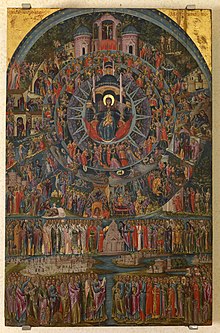Georgios Klontzas | |
|---|---|
 In Thee Rejoiceth | |
| Born | 1535 |
| Died | 1608 |
| Nationality | Greek |
| Known for | Iconography and hagiography |
| Notable work | In Thee Rejoiceth, The Last Judgement |
| Movement | Cretan School |
| Spouse | Erginia Panteleo |
| Children | Maneas, Louka, Nikolaos, Marko, Iakovo-Ignatius |
Georgios Klontzas (Greek: Γεώργιος Κλώντζας, 1535-1608) also known as George Klontzas and Zorzi Cloza dito Cristianopullo, was a scholar, painter, and manuscript illuminator. He is one of the most influential artists of the post-Byzantine period. He defined the Cretan Renaissance. His artistic output included icons, miniatures, triptychs and illuminated manuscripts, commissioned by both Catholic and Orthodox patrons. He is known for occupying his icons with countless figures. The technique is extremely complex and unique to Klontzas. Andreas Pavias attempted this technique in the Crucifixion of Jesus. Klontzas's painting All Creation rejoices in thee is his most popular work. Klontzas influenced Theodore Poulakis he created an extremely similar painting called In Thee Rejoiceth. Klontzas's work is strongly influenced by the Venetian school. His triptychs strongly resemble the works of Gentile da Fabriano, namely the Intercession Altarpiece. Klontzas's Last Judgement resembles Michelangelo's Last Judgement in the Sistine Chapel. There are very close similarities. There is no indication that Klontzas saw the work but it is a possibility. According to the Institute of Neohellenic Research fifty-four items of his art exist today.[1][2][3][4]
- ^ Speake, Graham (2021). Georgios Klontzas Encyclopedia of Greece and the Hellenic Tradition. London And New York: Rutledge Taylor & Francis Group. p. 893. ISBN 9781135942069.
- ^ Nicol, Donald M. (2002). The Immortal Emperor The Life and Legend of Constantine Palaiologos, Last Emperor of the Romans. London, UK: Cambridge University Press. p. 73. ISBN 9780521894098.
- ^ Eugenia Drakopoulou (June 18, 2021). "Klotzas (Klontzas) Georgios". Institute for Neohellenic Research. Retrieved June 18, 2021.
- ^ Hatzidakis, Manolis & Drakopoulou, Eugenia (1997). Greek painters after the fall (1450-1830) Volume B. Athens, GR: Center for Modern Greek Studies E.I.E. pp. 89–91.
© MMXXIII Rich X Search. We shall prevail. All rights reserved. Rich X Search
